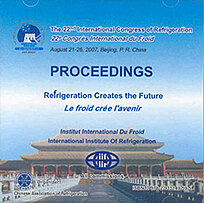
Résumé
As Chinese economy developing rapidly, traffic problems in Beijing have become more and more serious. The city's subway system, as one of the means of solving traffic problems, has had great development. Given the passengers' desire for a more comfortable environment, installing air-conditioning systems in subway trains and subway stations has become a necessary trend. The power energy consumption of subway trains is huge. How to change the electro-mode reasonably and reduce power energy consumption has become an urgent problem that needs to be solved. This paper calculates the cooling load of a subway station in Beijing and compares a conventional air-conditioning system with an ice thermal storage system in first cost, running cost and power energy consumption. Furthermore, this paper analyzes the feasibility that applies air supply under low temperatures in the subway. It decreases the operating electricity consumed and reconciles the contradiction with respect to electric shortages. The results show that it is feasible to apply an ice thermal storage air-conditioning system in the subway station and could reveal an energy saving potential.
Documents disponibles
Format PDF
Pages : ICR07-E1-1543 6 p.
Disponible
Prix public
20 €
Prix membre*
Gratuit
* meilleur tarif applicable selon le type d'adhésion (voir le détail des avantages des adhésions individuelles et collectives)
Détails
- Titre original : Analysis on the application of ice thermal storage air-conditioning system in subway stations in Beijing.
- Identifiant de la fiche : 2007-2282
- Langues : Anglais
- Source : ICR 2007. Refrigeration Creates the Future. Proceedings of the 22nd IIR International Congress of Refrigeration.
- Date d'édition : 21/08/2007
Liens
Voir d'autres communications du même compte rendu (839)
Voir le compte rendu de la conférence
Indexation
-
Research on the improving of submarine inhabiti...
- Auteurs : WU G., ZHONG M. J., ZEN Q. H., et al.
- Date : 21/08/2007
- Langues : Anglais
- Source : ICR 2007. Refrigeration Creates the Future. Proceedings of the 22nd IIR International Congress of Refrigeration.
- Formats : PDF
Voir la fiche
-
Numerical study on the performance of ice-based...
- Auteurs : LI Y., YANG C., WANG X., et al.
- Date : 21/08/2007
- Langues : Anglais
- Source : ICR 2007. Refrigeration Creates the Future. Proceedings of the 22nd IIR International Congress of Refrigeration.
- Formats : PDF
Voir la fiche
-
Optimization of the operating strategy for an i...
- Auteurs : ZHAO J. D., LIU N., LIU G.
- Date : 21/08/2007
- Langues : Anglais
- Source : ICR 2007. Refrigeration Creates the Future. Proceedings of the 22nd IIR International Congress of Refrigeration.
- Formats : PDF
Voir la fiche
-
Modified RC thermal circuit model applied to co...
- Auteurs : CHIANG Y. C., CHIEH J. J., CHEN H. C., et al.
- Date : 2005
- Langues : Anglais
- Source : ASHRAE Transactions. 2005 Winter Meeting. Volume 111, part 1 + CD-ROM.
Voir la fiche
-
Average modified Stanton number for evaluating ...
- Auteurs : OHIRA A., SAKANO Y., YANADORI M., et al.
- Date : 2004
- Langues : Anglais
- Source : ASHRAE Transactions. 2004 Winter Meeting. Volume 110, part 1 + CD-ROM.
Voir la fiche
